Abstract
A study of the health of 78 workers in an iron and steel foundry in Vancouver, British Columbia, was carried out and the results compared with those found in 372 railway repair yard workers who were not significantly exposed to air contaminants at work. The foundry workers were exposed to PepSet, which consists of diphenyl methane diisocyanate (MDI) and phenol formaldehyde and their decomposition products as well as to silica containing particulates. A questionnaire was administered by trained interviewers, and chest radiography, allergy skin tests, pulmonary function tests, and methacholine inhalation tests were carried out as well as measurement levels of dust and MDI. Compared with the controls, the foundry workers had more respiratory symptoms and a significantly lower mean FEV1 and FEF25-75% after adjustments had been made for differences in age, height, and smoking habit. Three workers (4.8%) had radiographic evidence of pneumoconiosis and 12 (18.2%) had asthma defined as presence of bronchial hyperreactivity, cough, and additional respiratory symptoms such as wheeze, chest tightness, or breathlessness. Sensitisation to MDI is probably the cause of asthma in these workers.
Full text
PDF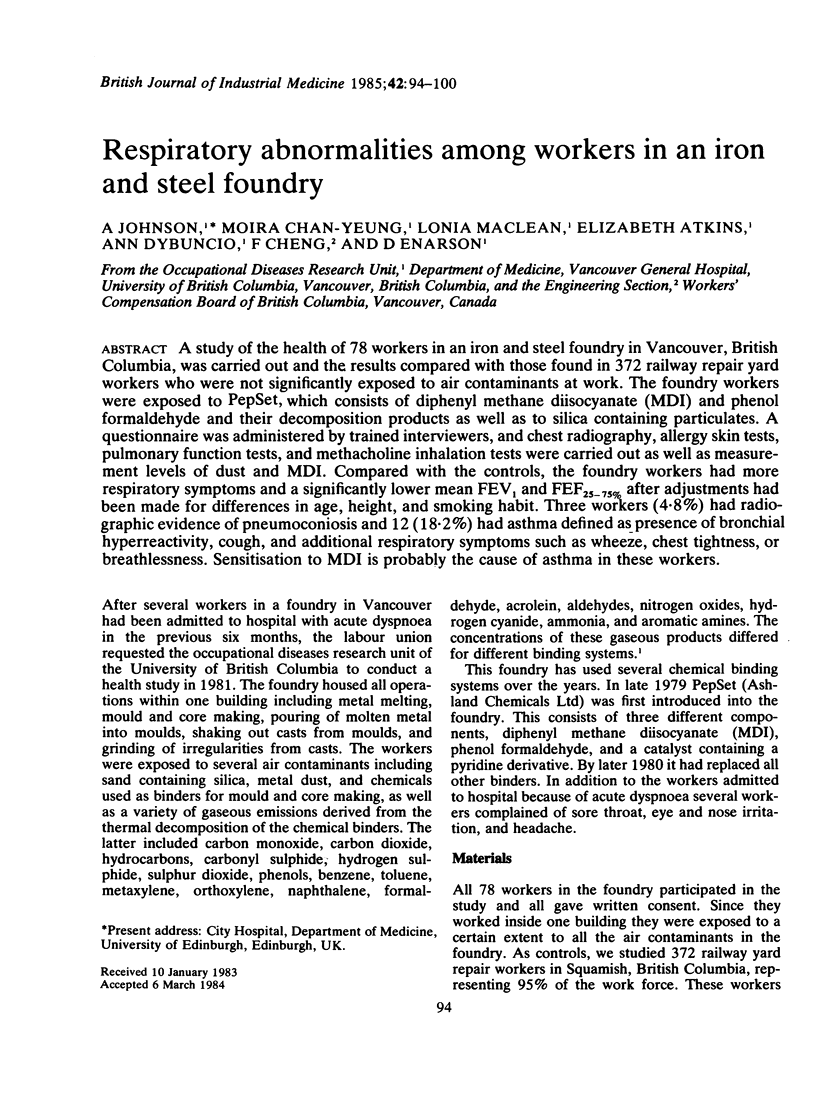

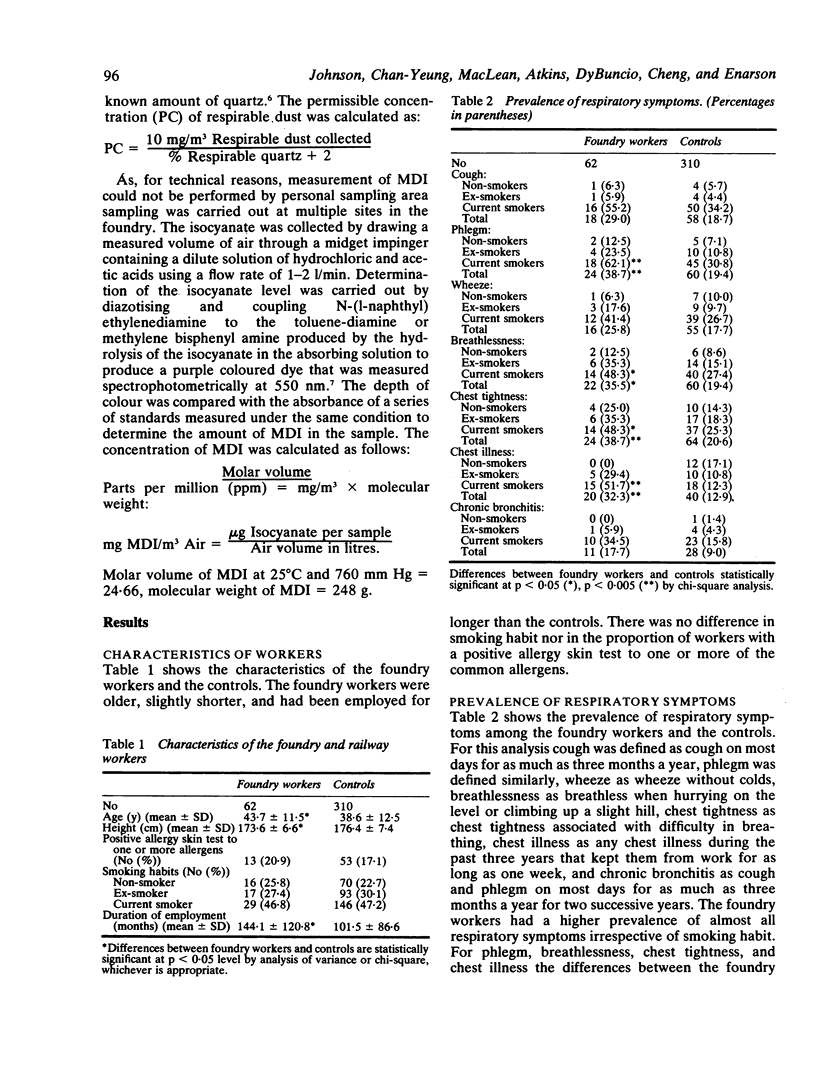
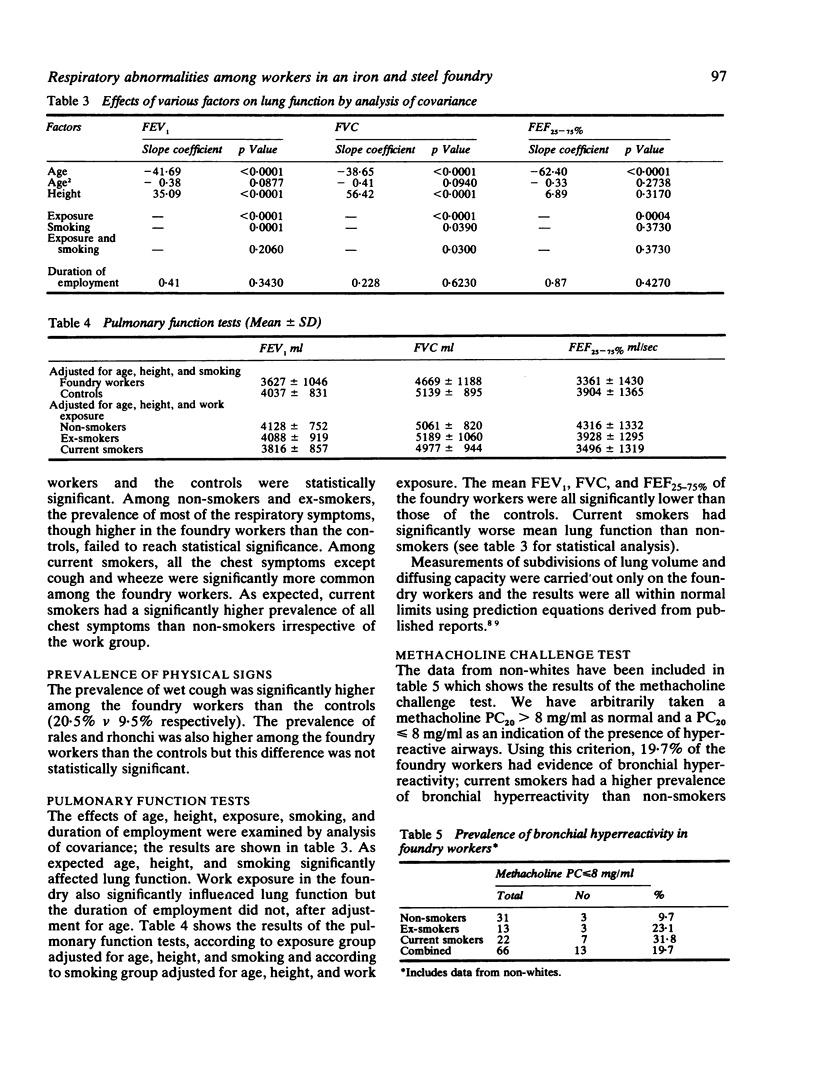
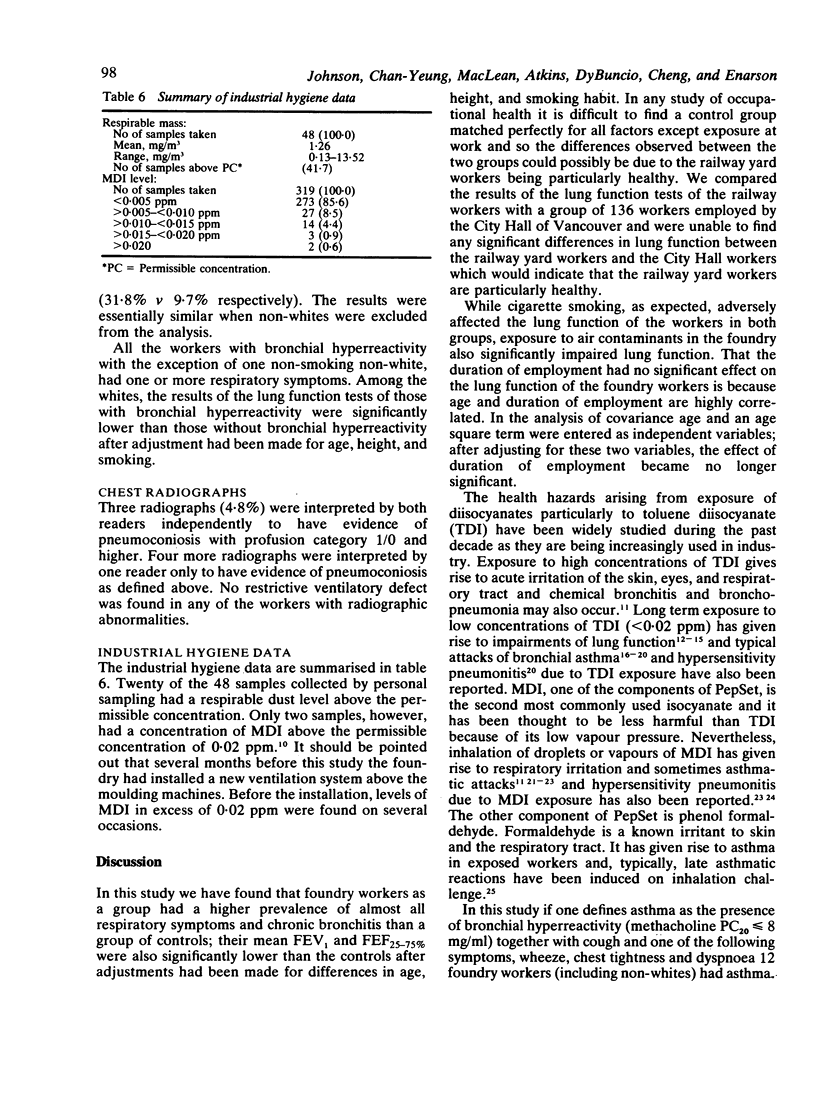
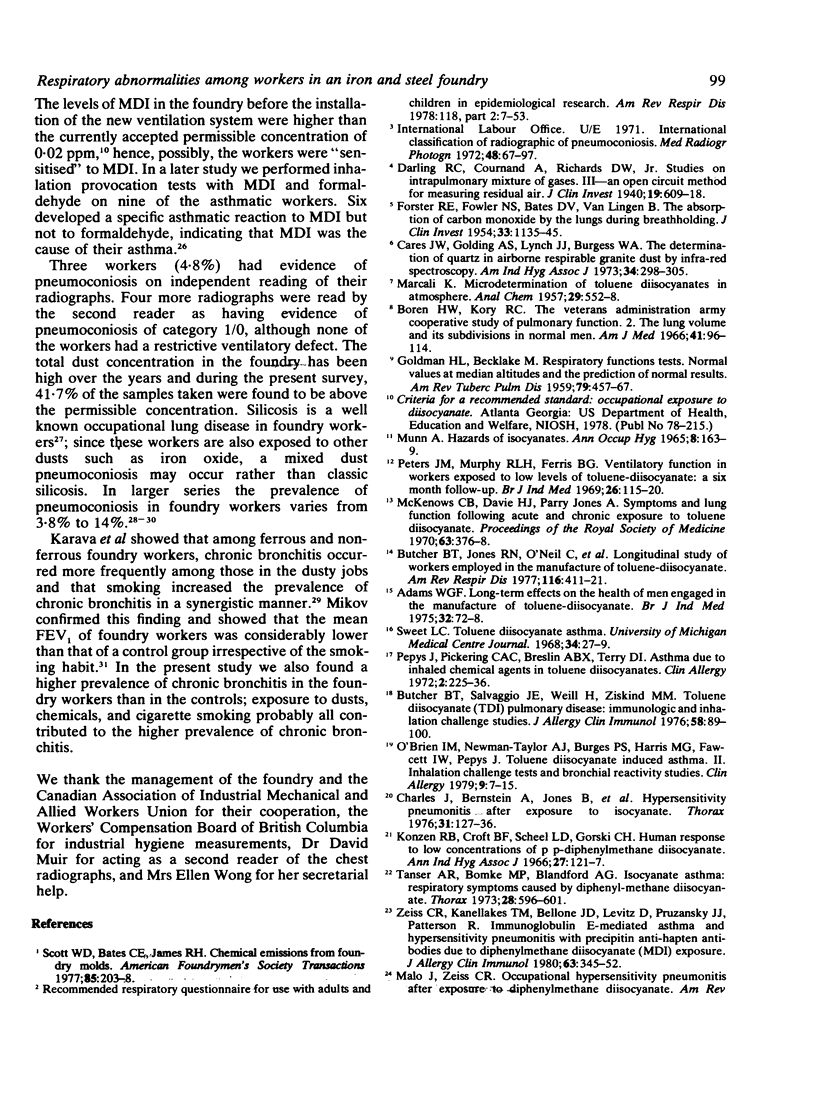
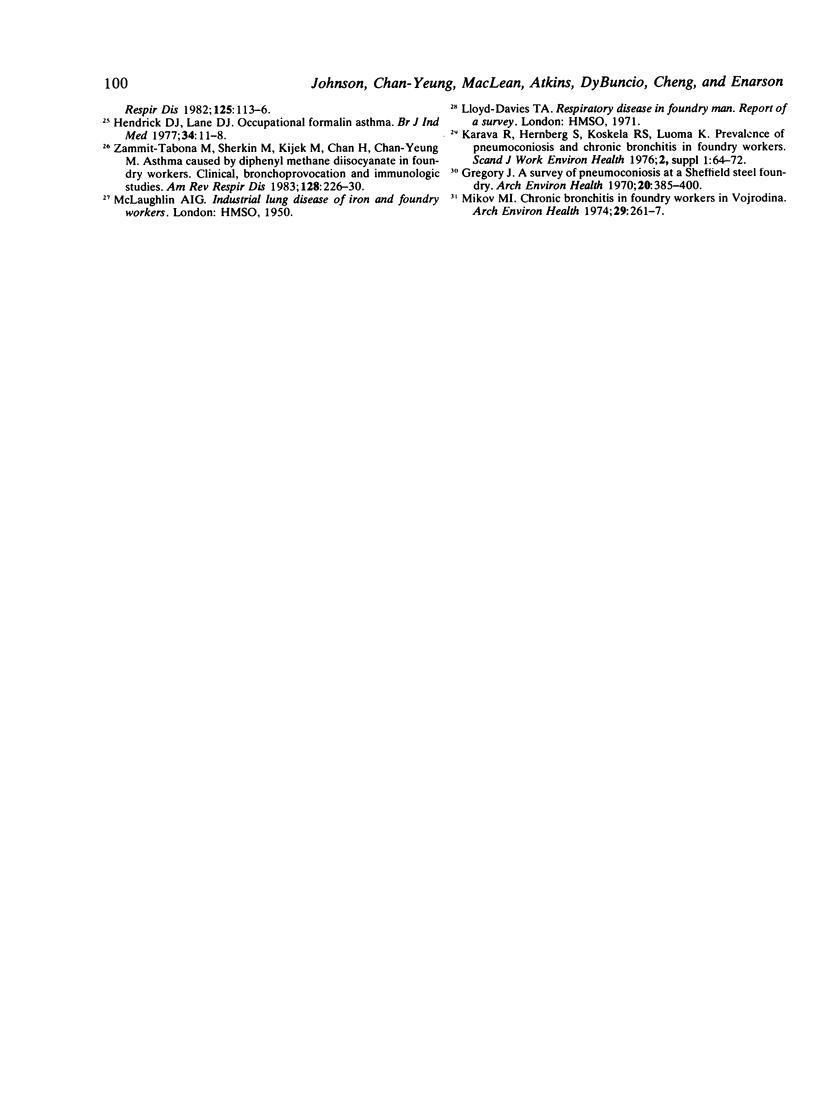
Selected References
These references are in PubMed. This may not be the complete list of references from this article.
- Adams W. G. Long-term effects on the health of men engaged in the manufacture of tolylene di-isocyanate. Br J Ind Med. 1975 Feb;32(1):72–78. doi: 10.1136/oem.32.1.72. [DOI] [PMC free article] [PubMed] [Google Scholar]
- Butcher B. T., Jones R. N., O'Neil C. E., Glindmeyer H. W., Diem J. E., Dharmarajan V., Weill H., Salvaggio J. E. Longitudinal study of workers employed in the manufacture of toluene-diisocyanate. Am Rev Respir Dis. 1977 Sep;116(3):411–421. doi: 10.1164/arrd.1977.116.3.411. [DOI] [PubMed] [Google Scholar]
- Butcher B. T., Salvaggio J. E., Weill H., Ziskind M. M. Toluene diisocyanate (TDI) pulmonary disease: immunologic and inhalation challenge studies. J Allergy Clin Immunol. 1976 Jul;58(1 Pt 1):89–100. doi: 10.1016/0091-6749(76)90110-x. [DOI] [PubMed] [Google Scholar]
- Cares J. W., Goldin A. S., Lynch J. J., Burgess W. A. The determination of quartz in airborne respirable granite dust by infrared spectrophotometry. Am Ind Hyg Assoc J. 1973 Jul;34(7):298–305. doi: 10.1080/0002889738506850. [DOI] [PubMed] [Google Scholar]
- Charles J., Bernstein A., Jones B., Jones D. J., Edwards J. H., Seal R. M., Seaton A. Hypersensitivity pneumonitis after exposure to isocyanates. Thorax. 1976 Apr;31(2):127–136. doi: 10.1136/thx.31.2.127. [DOI] [PMC free article] [PubMed] [Google Scholar]
- Darling R. C., Cournand A., Richards D. W. STUDIES ON THE INTRAPULMONARY MIXTURE OF GASES. III. AN OPEN CIRCUIT METHOD FOR MEASURING RESIDUAL AIR. J Clin Invest. 1940 Jul;19(4):609–618. doi: 10.1172/JCI101163. [DOI] [PMC free article] [PubMed] [Google Scholar]
- FORSTER R. E., FOWLER W. S., BATES D. V., VAN LINGEN B. The absorption of carbon monoxide by the lungs during breath-holding. J Clin Invest. 1954 Aug;33(8):1135–1145. doi: 10.1172/JCI102987. [DOI] [PMC free article] [PubMed] [Google Scholar]
- GOLDMAN H. I., BECKLAKE M. R. Respiratory function tests; normal values at median altitudes and the prediction of normal results. Am Rev Tuberc. 1959 Apr;79(4):457–467. doi: 10.1164/artpd.1959.79.4.457. [DOI] [PubMed] [Google Scholar]
- Gregory J. A survey of pneumoconiosis at a Sheffield steel foundry. Arch Environ Health. 1970 Mar;20(3):385–400. doi: 10.1080/00039896.1970.10665609. [DOI] [PubMed] [Google Scholar]
- Hendrick D. J., Lane D. J. Occupational formalin asthma. Br J Ind Med. 1977 Feb;34(1):11–18. doi: 10.1136/oem.34.1.11. [DOI] [PMC free article] [PubMed] [Google Scholar]
- Konzen R. B., Craft B. F., Scheel L. D., Gorski C. H. Human response to low concentrations of p,p-diphenylmethane diisocyanate (MDI). Am Ind Hyg Assoc J. 1966 Mar-Apr;27(2):121–127. doi: 10.1080/00028896609342803. [DOI] [PubMed] [Google Scholar]
- Kärävä R., Hernberg S., Koskela R. S., Luoma K. Prevalence of pneumoconiosis and chronic bronchitis in foundry workers. Scand J Work Environ Health. 1976;2 (Suppl 1):64–72. doi: 10.5271/sjweh.2830. [DOI] [PubMed] [Google Scholar]
- McKerrow C. B., Davies H. J., Parry Jones A. Symptoms and lung function following acute and chronic exposure to tolylene diisocyanate. Proc R Soc Med. 1970 Apr;63(4):376–378. [PMC free article] [PubMed] [Google Scholar]
- Mikov M. I. Chronic bronchitis in foundry workers in Vojvodina: ventilatory capacity in foundry workers. Arch Environ Health. 1974 Nov;29(5):261–267. doi: 10.1080/00039896.1974.10666584. [DOI] [PubMed] [Google Scholar]
- O'Brien I. M., Newman-Taylor A. J., Burge P. S., Harries M. G., Fawcett I. W., Pepys J. Toluene di-isocyanate-induced asthma. II. Inhalation challenge tests and bronchial reactivity studies. Clin Allergy. 1979 Jan;9(1):7–15. doi: 10.1111/j.1365-2222.1979.tb01517.x. [DOI] [PubMed] [Google Scholar]
- Pepys J., Pickering C. A., Breslin A. B., Terry D. J. Asthma due to inhaled chemical agents, tolylene di-isocyanate. Clin Allergy. 1972 Sep;2(3):225–236. doi: 10.1111/j.1365-2222.1972.tb01287.x. [DOI] [PubMed] [Google Scholar]
- Peters J. M., Murphy R. L., Ferris B. G., Jr Ventilatory function in workers exposed to low levels of toluene diisocyanate: a six-month follow-up. Br J Ind Med. 1969 Apr;26(2):115–120. doi: 10.1136/oem.26.2.115. [DOI] [PMC free article] [PubMed] [Google Scholar]
- Sweet L. C. Toluene-diisocyanate asthma. Univ Mich Med Cent J. 1968 Jan-Feb;34(1):27–29. [PubMed] [Google Scholar]
- Tanser A. R., Bourke M. P., Blandford A. G. Isocyanate asthma: respiratory symptoms caused by diphenyl-methane di-isocyanate. Thorax. 1973 Sep;28(5):596–600. doi: 10.1136/thx.28.5.596. [DOI] [PMC free article] [PubMed] [Google Scholar]
- Zammit-Tabona M., Sherkin M., Kijek K., Chan H., Chan-Yeung M. Asthma caused by diphenylmethane diisocyanate in foundry workers. Clinical, bronchial provocation, and immunologic studies. Am Rev Respir Dis. 1983 Aug;128(2):226–230. doi: 10.1164/arrd.1983.128.2.226. [DOI] [PubMed] [Google Scholar]


